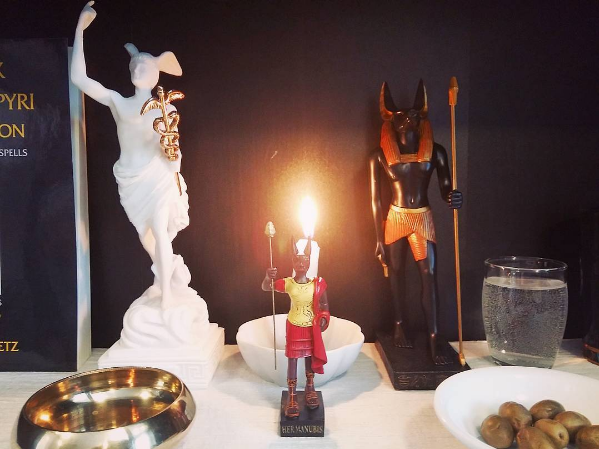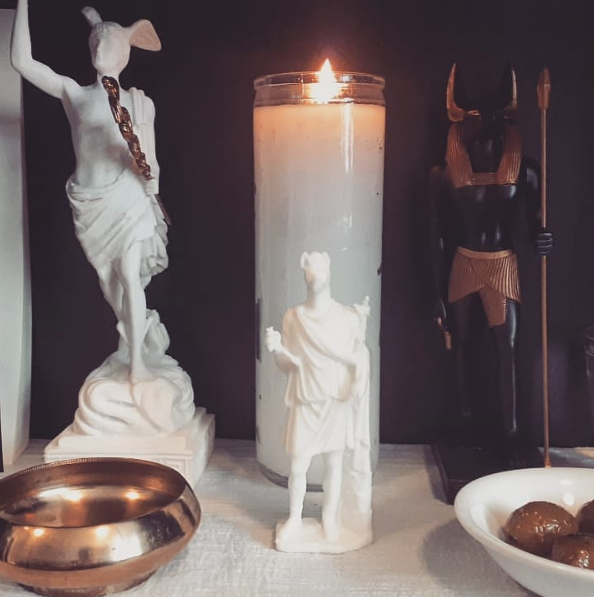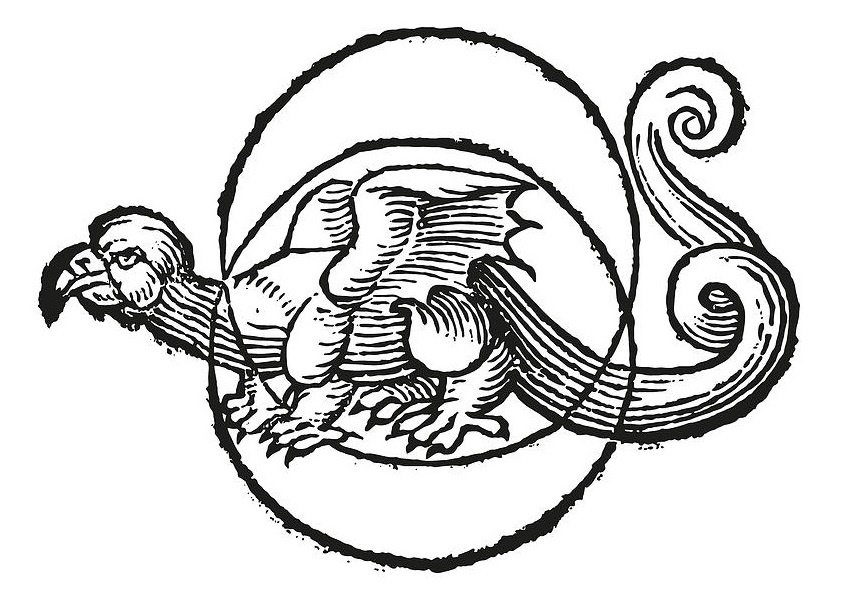I took notice and became interested in Sphere + Sundry’s offerings in the same year I began experimenting with astrological talismans. At the time, one of my best friends, who goes by Hex, had begun studying scholastic image magic. Whenever he found an appropriate election, he would also message our friend group of magicians with the times for their respective cities and the general instructions for making the talismans. A few months later, Salt himself signed up for Christopher Warnock’s astrological magic course and he too joined in the hunt for elections. Over the course of the last year we’ve made an assortment of planetary and fixed star talismans using the appropriate metals and gemstones. While I am not currently studying the same art, being more immersed in other projects relating to my traditions of witchcraft, the grimoires I am procuring tools for, and my Quimbanda lineage, I have come to deeply respect and enjoy the power of astrological talismans in my practice. Their magic feels so clean and elevated it sings; bending reality around them to flow with the tides of that particular celestial moment they capture and eternally embody.
Run by Kaitlin and Austin Coppock, Sphere + Sundry create more than just your standard talismans. Their range of products include oils, candles, inks, hydrosol sprays, incenses, collaborations with perfumers, jewelers, and blacksmiths, and a host of other elected tools and materia all having been crafted to the strictest standards within the time frames allotted. Even the very bottling and packaging is carefully done within the right times, and the bottles and jars themselves are never branded. You can read more about their philosophy and approach at their website [here]. Both Salt and I have had nothing but excellent experiences with their work—in fact, part of my Christmas gifts for him last year involved a few of their Exalted Mars offerings in addition to a set of the seven pentacles of Mars in iron. The results he’s had with them in conjunction have been nothing short of remarkably powerful. As for myself, their main line I work with is their Hermanubis collection, of which I have almost a complete set. Given that they see such regular use, I thought I would offer a review of the line here for those interested in both the set itself and their products more broadly.
Before I get into the review proper, I wanted to briefly comment on Hermanubis himself. I first began engaging with the god two years ago, shortly before I read Gordon White’s The Chaos Protocols in which he is famously recommended. I was led to him by a cynocephalic spirit familiar Hekate had bestowed me, who referred to Hermanubis as one of his masters. Intrigued by the syncretized Hermes-Anubis psychopomp deity, I printed out a picture of his statue in the Vatican museum and set him up with a tealight and a glass of water in the corner of one of my necromantic working altars. Since then, his guidance and erudition have been the catalyst of some of the most important breakthroughs in my witchcraft, spirit work, and general understanding of magic. There is a distinct elegance, a celestial current flowing within the sea of the dead he shepherds, a starry overtone to his shadowed approach; a mercurial swiftness embedded within his darksome guidance. While there is no shortage of psychopomps and death-beings in my life, from St. Cyprian of Antioch, Veles, and Hekate to the Exus of my Quimbanda court, Hermanubis has a distinct and deeply valued place among my spirits and my attempts to further ingress his mysteries have yielded important sorcerous fruit.
As my relationship with him grew, so too did his shrine. The framed picture of his statue was soon replaced with figures of Hermes, Yinepu/Anubis, and a little figurine of Hermanubis from the Hachette “Gods of Ancient Egypt” series. I created the APHEROU (“way opener”) brass bowl for scrying and conjuring the dead using the instructions in The Chaos Protocols and set aside the usual space for candles, water, and food.

In purchasing the Hermanubis series from Sphere + Sundry, I was specifically interested in further cultivating the god’s presence in my life as well as having properly-enchanted materia on hand to bring his essence and power into other domains of spellcraft, sorcery, and spirit work. I am reviewing everything available in the series except for the beeswax candle.

Here is what they look like together out of the box. Inside the package was a bottle of Oil of Hermanubis, a bottle of Ink of Amenti in a 1/8 oz glass vial, a vial of Natron, some Way Opening Dead-Drawing Elixir in a 1/2 oz glass bottle, a bottle of Hermanubis Self-Igniting Incense, a 5″ Hermanubis statue in white, and the accompanying Opening of the Mouth and Eyes Ritual. As with all Sphere + Sundry shipments, they came packed with a few chocolates which were promptly devoured. No pictures/traces of evidence for those.
Let’s begin with the most immediately striking: the figurine. Its presence in the collection is owed to Oliver Laric’s Three D Scans, a project involving copyright-free 3D models of statues from various museums. Unless you commission your own or buy one of the Hachette figurines like I did, this is one of the only few actual statues of Hermanubis available. It’s a lightweight, 5″, standard 3D-printed figure that looks just like the Vatican museum statue. You have a choice of white or black in the listing. I went with white to match the marble of the original.
Accompanying the statue is a ritual to perform a take on the Opening of the Mouth ceremony, to better enliven and consecrate it as an icon of the god. Performing the ritual was the first time I actually used most of the products; I received my package late on Halloween (auspicious!) and wanted to wait until it was the Mercury hour on the following Saturday to carry it out. Until then, I kept the vials wrapped in black silk in a black cauldron that sits on the Hermanubis shrine.
When it was time, I withdrew the oil, elixir spray, incense, and natron and procured a series of offerings to the god—breads, olives, alcohol, spring water, and so on. I cleaned the statue with purified water and natron, anointed its eyes and lips with the oil, “cut” them with a ritual knife bathed in the smoke, and sprayed the entire figure with the elixir. I did the same for my other statues and figurine as well and then sat in communion with the spirits as the offerings were presented. The combination of the incense, oil, and elixir truly emanate, enhance, and vivify that exact blend of Hermes Chthonius and Yinepu heka made manifest in the spirit of Hermanubis as I’ve come to know him. The sensation that fills the room when even one is used sings with the same power that builds after I’ve spent some time praying and invoking at the main shrine, having plunged deeper into the work—though elevated to an even stronger degree. I find that now, all it takes to stir the same level of attention, focus, and presence of the spirits at the shrine is to open with a prayer and mist the space with the elixir.
I tend save the incense for larger workings as the bottle is quite small. A myrrh resin blended with a herbal mixture aligned to Hermanubis along with some black dog hair, the powder is self-igniting. While it can be used as an offering to the dead and to Hermanubis himself, I’ve chosen to use it only in important chthonic rituals in which I really want to draw, wake, and gather the dead or other such spirits and facilitate their conjuration.
The elixir, along with the oil, are my favourite pieces. To quote the listing:
Dark red wine and high proof spiced rum were ritually infused with herbal attractants for drawing the dead, blessed by Hermanubis as the Sun set on the day of Mercury’s exalted direct cazimi 2018.
The bottle is similarly prepared with copper leaf, echoing the concept of paying pennies to traffic with the dead. While I have yet to use this at a cemetery (which can be done to wake particular graves), I have mostly employed it to great effect at my ancestor altar, at a boveda during seance, and to baptize particular necromantic tools. Before I use it, I always begin by delineating the appropriate boundaries, naming precisely which forces I am calling, and ensuring that several of my helping spirits and familiars are at my side to guard the gates, as it were. Similarly, as is advised, I banish, cleanse, and re-anoint the windows and thresholds of my working space with holy oil once I’ve finished. I also give offerings to my spirits in thanks for monitoring what flows through my walls. When sprayed, the atmospheric change is unmistakable. I find that my psychic senses are instantly elevated and attuned to the frequencies of the dead, that the spirits more easily manifest and take form in my compasses and circles, and that the clarity of their messages and warnings are distinctly improved. Extremely versatile and consistently potent in every circumstance I’ve used it in, I would highly recommend the elixir to any witch; whether you work with Hermanubis or not. As long as the chthonic have a place in your practice, you will benefit from this water.
The oil packs a similar punch, albeit in a far more earthy, concentrated form. The description given for its contents on the listing is:
As the Sun descended into the realm of the underworld on the day of Mercury’s exalted cazimi 2018, organic cold-pressed olive oil was combined with ritually harvested cemetery cypress, hops, barley, and other herbs and ingredients sacred to Hermes, Anubis, or favored by the dead, along with myrrh, hair from a black dog, and 24k gold leaf.
After opening the mouths of my statues, I used the oil to anoint the offering plates and gifts belonging to my dead, five-spot their working spaces to further anchor their presence as liminal hedges of communion, and further empower particular tools—such as a wand made from the oldest yew tree in a British churchyard. A few of my familiars have taken a particular liking to this oil and I’ve used a small dab of it to further solidify their grasp and influence over workings I’ve done with them. Again, I’ve noticed consistently their manifestations have only ever been enhanced through this oil’s use. I’ve actually found that carrying it with me in my bag of throwing bones has served as a kind of battery and beacon to spirits in general. I’ve also anointed myself with it prior to going on cemetery walks to open myself further to the whisperings of my allies there, as well as in seances and any such sessions involving channeling and divination. Alongside my own Hekate oil, made through Jason Miller’s recipe in his Sorcery of Hekate arcana, this is my go-to oil for necromancy now. One interesting use I’ve come to discover is that if I lightly dab a wrapped offering or a particular working fetish, doll, or bundle I am disposing of at crossroads or cemeteries, specifically while charging and praying over the oil as I’m shaking and using it, the spirits in these spaces are immediately provoked to action far more quickly. It’s a powerful way to “mark” something as theirs now, whether it is a gift like a meal or bottle of alcohol, or a working bundle that draws their intercession.
The Ink of Amenti has been used solely for my work with a particular black book I keep. I’ve poured a small amount of it out into a larger vial of plain ink, fumigated it with myrrh incense, and consecrated it as another batch of necromantic ink through dilution. I tend to treat the vessels in which my ritual inks and oils are housed as living entities, especially since I’ve begun to make my own oils during specified times and with ritually-harvested ingredients. My mother bottles all have personalities of their own and I treat their bottling and pouring with reverence. So while the original bottle my ink came in is paired with that black book, some of it was reincarnated into a new, diluted form and saved for future work. As for its effects, I’ve noticed that what I write with it glows hazily in my psychic vision, especially in the dark, and that it has cemented the influence of the spirits whose seals and pacts are within that book in an interesting way. Namely, when I use ink from the same bottle to write petitions, commands, sigils, etc. on other pieces of parchment, the spirits of my grimoire can be instantly stirred just by their writing prior to any formal conjuration. A proper link has been forged between the agreements in the book and whatever I write with the bottle, as overseen by the chief binding spirits who authorize the contracts. As such, I’ve been able to more quickly launch these spirits to action through its use.
As for the natron, I’ve found the most practical way for me to use the special properties of this vial is to divide it among other existing purifying salts I have. I’ve mixed some with a larger batch of natron I have that I use for purifying baths and another portion with a jar reserved only for drawing circles. Again, to better blend them, I fumigated these jars with incense to combine them as one. There is little left in the original vial as it is now. Much of it was used immediately in the purification and consecration of various different statues and figures of the gods and spirits I’ve adapted the accompanying ritual for.

I referred to the elixir as extremely versatile and consistently potent, but really this applies to the series in general. You don’t need to work with Hermanubis to benefit immensely from these tools as enriching way-openers for all magic concerning the dead and travel to and from their worlds. If you’re thinking of beginning a relationship with the deity, these offerings will draw the attention and focus of the right spirits easily. If you’re struggling which to choose, I would pick between the oil and elixir depending on how you envision working with these powers, whether you prefer to anchor and anoint specific points or permeate and uplift the air around. With both you’ll be set for a long time indeed. While there aren’t many left, if you’re willing to spend a little extra I think the Statue and Opening of the Mouth Ritual Set is ideal; it’s not only well-priced but you get a sample of the majority of the offerings including one of the replica figurines. And if this particular lineup isn’t your calling, do consider checking their other series for something undoubtedly equally potent but better tuned to your needs.
